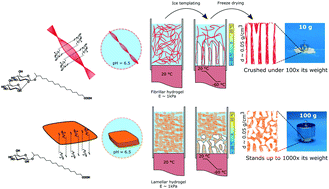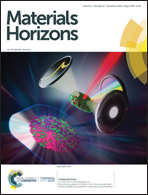Soft lamellar solid foams from ice-templating of self-assembled lipid hydrogels: organization drives the mechanical properties†
Abstract
Ice-templating, also referred to as freeze-casting, is a process exploiting the unidirectional crystallization of ice to structure macroporous materials from colloidal solutions. Commonly applied to inorganic and polymeric materials, we employ it here to cast soft self-assembled matter into spongy solid foams. Use of ice-templating to cast soft matter is generally confined to polymers. In the case of polymeric hydrogels, cross-linking ensures a good stability towards harsh conditions (fast cooling at temperatures as low as −80 °C) employed during ice-templating. However, freeze-casting of soft systems held together by weak interactions, like in physical gels, has not been explored, because the nonequilibrium conditions could easily disrupt the nano and macroscale organization of the self-assembled matter, resulting in a cruel loss of mechanical properties. Whether this is a general assumption or a more specific relationship exists between the structure of the physical gel and the properties of the macroporous solid after ice-templating is the question addressed in this work. We compare two self-assembled lipid hydrogels, of analogous chemical composition and comparable elastic properties under ambient conditions, but different structure: isotropic entangled self-assembled fibers against a heterogeneous lipid lamellar phase. Our results show that both materials possess the same phase (fibrillar and lamellar) before and after freeze-casting but the mechanical properties are absolutely the opposite: the fibrillar hydrogel provides a brittle, highly anisotropic, macroporous fibrous solid while the lamellar hydrogel provides a soft, spongy, solid foam with isotropic Young's moduli of several kPa, in the same order of magnitude as some soft living tissues.

- This article is part of the themed collection: A selection of 2019 articles


 Please wait while we load your content...
Please wait while we load your content...